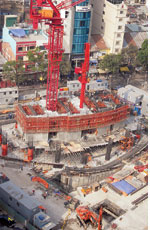Governments throughout the world are pouring trillions of dollars into their economies to halt their decline and stimulate recovery. It’s still too early to detect results, and in most places construction has ground to a halt. But in Vietnam, a skyscraper continues to rise. Toronto also is relatively unscathed, thanks to pent-up demand for office space, and Calgary’s market is still floating on oil.


“On a relative basis there is work in Vietnam, whereas work has stopped in India, Russia, Dubai and other places,” says Nicholas Bilotti, president of Turner International. Turner has three projects in Vietnam that are moving forward, including a skyscraper called Bitexco. “American companies continue to build while the developers building commercial, retail and hotel work have stopped internationally.”
In Canada, few commercial building projects have been mothballed or cancelled outright. The notable exception is Vancouver, where a number of high-profile mixed-use projects have stopped.
“We are hearing of a number of condo projects that are being parked, rather than being killed,” says Keith Sashaw, president of Vancouver Regional Construction Association.
But in downtown Toronto, three new office towers are under construction, says Paul Morse, senior vice president with Cushman & Wakefield LePage Inc. One reason for the Toronto market’s strength is that commercial tower construction in the downtown has been dormant for more than a decade. “There’s still a demand for well-built and designed green office space,” Morse says.
In Germany, “Our estimate is that the stimulus for the complete construction sector is worth about $10.4 billion a year,” says Heinrich Weitz, and analyst with the contractors’ association Hauptverband der Deutschen Bauindustrie, Berlin. That corresponds to over 3% of all German construction spending last year.
In the next two years, federal spending on major infrastructure will rise by $2.6 billion a year, adds Weitz. However, accounting for some 60% of German construction spending, the subnational governmental bodies “are the most important group,” he says. The federal government will provide $13 billion of stimulus funds this year and next for local governments, which will add $4.3 billion themselves.
In France, an intergovernmental committee early this month identified 1,000 projects that would start earlier with France’s stimulus package. New investments include $1.1 billion for road, rail and waterway infrastructure improvements and maintenance. A similar amount will be allocated for three new highways. Other measures include over $1.3 billion, mainly for upgrading public housing.
The U.K. government plans to bring forward $4.5 billion of capital spending from 2010-11 to 2009-10. Around a third will be spent by the Dept. for Transport on new projects and upgrades. This month, the agency announced another $100 million for highway maintenance.
China’s $586-billion stimulus package announced last November was originally criticized as lacking detail of true size and implementation but has started taking shape. Equivalent to 1.5% of China’s GDP, the plan squeezes spending originally intended for a five-year budget into two years. It will support nine so-called “pillar” industries highlighted by the National Development and Reform Commission (NDRC), including light industry, textile, steel, non-ferrous metal, automobile, petrochemical, shipbuilding, electronics and telecommunications.
The commission, essentially the country’s economic planner, announced in November that $173 billion would be arranged for investment from the central budget by the end of 2010. The remaining sum would draw from local governments and nongovernmental sectors to total $585 billion in investment across the country.




Post a comment to this article
Report Abusive Comment